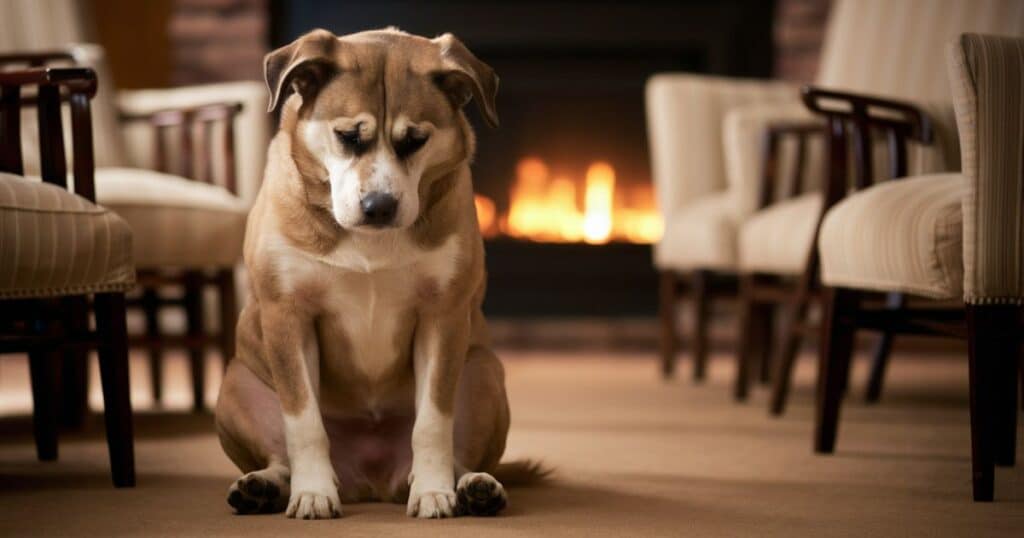Have you ever walked into a room, expecting to find your furry friend excitedly wagging their tail, only to realize they’re nowhere in sight? You search the house, perplexed, until you finally locate them sitting alone in another room, away from the family. This behavior can leave many dog owners wondering, “Why does my dog sit alone in another room?”
While it may seem perplexing at first, there are numerous potential reasons behind this conduct, ranging from medical issues to emotional needs. By understanding the possible causes, you can better support your canine companion and ensure their well-being. Let’s dive into the various explanations for this behavior and explore how to help your pup if they frequently retreat to solitary spaces.
Reasons Why Dogs Sit Alone in Another Room
Signs Your Dog is Sitting Alone due to Fear or Anxiety
One of the most common reasons for a dog to seek solitude is fear or anxiety. If your pup is exhibiting signs such as shaking, panting, or tucking their tail between their legs while isolated, it could indicate they’re feeling overwhelmed or threatened by something in their environment.
Potential triggers for this behavior include:
- Loud noises: Thunderstorms, fireworks, construction, or even loud music or voices can startle and frighten dogs, causing them to seek refuge in a quiet space.
- Unfamiliar people or animals: New guests, visitors, or even a recent addition to the household can make some dogs feel uneasy, prompting them to retreat to a familiar, secluded area.
- Being left alone: Separation anxiety is a common issue in dogs, where they experience distress and panic when their owners leave, leading them to hide or isolate themselves.
- Traumatic past experiences: Dogs who have endured abuse, neglect, or traumatic events may develop fear-based behaviors and seek solitude as a coping mechanism.
It’s essential to identify and address the root cause of your dog’s fear or anxiety. This may involve gradual desensitization techniques, creating a safe space for them to retreat to, or seeking professional help from a certified animal behaviorist or veterinarian.
“Fear is a natural response to a perceived threat, and it’s important to recognize and address it in a compassionate and positive way.” –
Dr. Karen Becker, Veterinarian
MORE POST: The Unique Dudley Labrador: A Comprehensive Guide
Signs Your Dog is Sitting Alone due to Illness or Pain

If your dog’s solitary behavior is a recent development, it could be a sign of an underlying medical issue or pain. Dogs tend to withdraw and seek quiet spaces when they’re not feeling well, as a way to conserve energy and rest.
Potential indicators of illness or pain include:
- Lethargy or lack of energy: A sudden decrease in your dog’s activity levels or willingness to play could be a warning sign.
- Loss of appetite: A disinterest in food or a significant reduction in their usual appetite can indicate discomfort or illness.
- Vocalizations: Whining, growling, or yelping can be your dog’s way of expressing their discomfort or pain.
- Difficulty moving or favoring certain limbs: If your dog seems to be limping or avoiding putting weight on a particular leg or area, it could signal an injury or joint issue.
Conditions like arthritis, dental problems, or internal issues like urinary tract infections or gastrointestinal distress can make it uncomfortable for your dog to remain in high-traffic areas or engage in regular activities. If you suspect your dog is experiencing discomfort, it’s crucial to schedule a veterinary appointment for a proper diagnosis and treatment plan.
Signs Your Dog is Sitting Alone due to Boredom or Lack of Stimulation
Dogs are intelligent, active creatures that require both mental and physical stimulation to thrive. If their needs for exercise, playtime, and enrichment aren’t being met, they may resort to sitting alone out of sheer boredom or frustration.
Telltale signs of boredom or understimulation include:
- Destructive behaviors: Chewing, digging, excessive barking, or other destructive tendencies when left alone or understimulated.
- Restlessness or hyperactivity: Pacing, circling, or an inability to settle down can indicate a need for more physical and mental exercise.
- Excessive sleeping or lethargy: While dogs do sleep a lot, if your pup seems excessively lethargic or sleeps more than usual, it could be a sign of boredom or depression.
To prevent this issue, it’s crucial to provide your dog with ample opportunities for exercise, training sessions, and interactive toys or puzzles that challenge their minds. Consider enrolling them in doggy daycare or hiring a dog walker to break up long stretches of alone time.
“A bored dog is an unhappy dog. Providing mental and physical stimulation is key to their well-being.”
Victoria Stilwell, Dog Trainer and Author
Signs Your Dog is Sitting Alone due to Aging
As dogs enter their senior years, they may start to exhibit new behaviors, including a preference for quiet, isolated spaces. This change can be attributed to several factors:
- Diminished senses: Decreased sight, hearing, or smell can make the world feel overwhelming, prompting older dogs to seek out calmer environments.
- Cognitive changes or confusion: Canine cognitive dysfunction, similar to dementia in humans, can cause disorientation and a need for familiar, secure spaces.
- Mobility issues or arthritis pain: Joint issues or chronic pain can make it challenging for senior dogs to move around comfortably, leading them to seek out soft, low-traffic areas.
- Increased need for rest and sleep: As dogs age, they require more rest and may prefer to nap in quiet, undisturbed spaces.
If your elderly dog has started spending more time alone, it’s essential to accommodate their evolving needs. Ensure they have a comfortable, easily accessible resting area with soft bedding and appropriate lighting. Additionally, consider providing mobility aids or modifying your home to make it easier for them to navigate.
Signs Your Dog is Sitting Alone due to Temperature Preference

Just like humans, dogs can have individual preferences when it comes to temperature and climate. Some dogs may seek out cooler or warmer rooms based on their thermal comfort levels.
For example, a dog with a thick coat may prefer to lounge in a cooler, air-conditioned space during hot summer months, while a short-haired breed may gravitate towards sunnier, warmer areas in the winter.
To accommodate your pup’s temperature preferences, you can:
- Provide cooling pads or fans: Set up these cooling aids in warm areas of your home during hot weather.
- Set up cozy heating pads or heated beds: Offer warm, toasty spots for your dog to snuggle up in during colder months.
- Ensure proper insulation and climate control: Maintain a comfortable, consistent temperature throughout your home to prevent your dog from seeking out extreme temperature zones.
By catering to your dog’s thermal needs, you can help ensure their comfort and reduce the likelihood of them retreating to specific rooms solely for temperature regulation.
Signs Your Dog is Sitting Alone due to Comfortable Surfaces
Dogs, like most creatures, appreciate a soft, comfortable surface to rest on. If your furry friend has taken a liking to a particular couch, chair, or dog bed in another room, it may simply be because they find that spot more appealing than the hard floors or carpets in other areas of the house.
To make your dog feel at home throughout your living space, consider:
- Placing plush dog beds or cushions: Provide cozy resting spots in each room, ensuring they have access to soft, supportive surfaces wherever they choose to relax.
- Using area rugs or runners: Cover hard floors in high-traffic zones with soft, cushioned rugs or runners to create a more inviting environment.
- Creating cozy nooks or caves: Set up enclosed spaces with blankets, pillows, and cushions, mimicking the den-like environments that dogs instinctively seek out.
By providing ample comfortable resting spots, your pup may be less inclined to seek out that one specific spot and more willing to stay near you and the family.
Signs Your Dog is Sitting Alone to Avoid Other Pets

In multi-pet households, dogs may occasionally seek solitude to escape the chaos or avoid conflicts with their furry housemates. This behavior can be especially common after introducing a new pet or if there are tensions between existing animals.
Signs that your dog is avoiding other pets include:
- Growling, snapping, or showing aggression: Displays of aggression towards housemates can indicate a desire for personal space or resource guarding.
- Retreating to a separate room: If your dog consistently leaves a room when other pets are present, they may be seeking solitude to avoid conflicts.
- Guarding resources: Protecting food, toys, sleeping areas, or even human family members
Signs Your Dog is Sitting Alone to Escape the Family
While dogs are often referred to as “man’s best friend,” even the most devoted pup can sometimes need a break from constant human interaction. This is especially true in households with young children, where the high energy levels and frequent handling can become overwhelming for a dog.
Your dog may be seeking solitude if you notice them:
- Retreating to another room when children are playing loudly or roughhousing: The noise and commotion can be too much for some dogs, prompting them to seek quieter spaces.
- Avoiding certain family members more than others: If your dog seems to steer clear of particular individuals, it could be due to fear, anxiety, or simply a preference for some people over others.
- Appearing irritable or exhibiting signs of stress around people: Behaviors like lip-licking, yawning, or a tense body posture can indicate that your dog is feeling overwhelmed and in need of a break.
It’s essential to respect your dog’s need for personal space and quiet time, just as you would for any family member. Designate a “dog-only” room or area where they can retreat when needed, and teach children how to interact with the dog respectfully.
“Dogs are social creatures, but they also need their alone time. Providing a safe space for them to decompress is crucial.”
Dr. Patricia McConnell, Certified Applied Animal Behaviorist
Signs Your Dog is Sitting Alone for Relaxation Time
While the previous reasons focused on potentially negative motivations, it’s important to remember that sometimes, dogs simply enjoy a little alone time for relaxation and decompression, just like humans do.
As long as your dog appears content, healthy, and is still receiving adequate exercise, playtime, and socialization, there’s no need for concern if they occasionally retreat to a quiet spot for some “me time.”
Signs that your dog is seeking relaxation include:
- Curling up in a comfortable spot for a nap: If your pup seems relaxed and unbothered, they may simply be indulging in a peaceful snooze.
- Appearing calm and unbothered by their surroundings: A lack of stress signals, like panting or restlessness, can indicate that your dog is at ease in their solitary space.
- Remaining in the same spot for an extended period without exhibiting stress signals: Prolonged stillness and calmness suggest that your dog is simply enjoying some quiet downtime.
It’s crucial to observe your dog’s overall behavior patterns and ensure their needs are being met. If the solitary behavior is accompanied by other concerning signs (lack of appetite, lethargy, etc.), it may indicate an underlying issue that requires further investigation.
Do Sick Dogs Like to Be Alone?
It’s not uncommon for dogs to seek solitude when they’re feeling under the weather. Just as humans may want to retreat to a quiet space when ill, dogs may instinctively isolate themselves as a way to conserve energy and rest.
If your dog’s solitary behavior is accompanied by other symptoms like lethargy, loss of appetite, vomiting, or diarrhea, it could be a sign of an illness or health concern that requires veterinary attention.
In some cases, it may be best to let a sick dog have their space and rest, as long as they’re still eating, drinking, and showing signs of improvement. However, if the symptoms persist or worsen, it’s essential to have your vet examine and treat your furry friend.
Due to Boredom or Lack of Stimulation
As mentioned earlier, dogs that don’t receive adequate mental and physical stimulation may retreat to solitary spaces out of sheer boredom or frustration. This behavior can manifest in various ways, such as:
- Destructive behaviors: Chewing on furniture, digging, or excessive barking when left alone for long periods without proper enrichment.
- Restlessness or hyperactivity: Pacing, circling, or an inability to settle down can indicate a need for more physical and mental exercise.
- Excessive sleeping or lethargy: While dogs do sleep a lot, if your pup seems excessively lethargic or sleeps more than usual, it could be a sign of boredom or depression.
To combat boredom and provide adequate stimulation, consider incorporating the following activities into your dog’s routine:
- Interactive toys and puzzles: Treat-dispensing toys, food puzzles, and other interactive games can provide mental stimulation and relieve boredom.
- Nose work or scent games: Encouraging your dog to use their natural scenting abilities can be both mentally and physically engaging.
- Rotate toys and activities: Introducing new toys or games on a regular basis can prevent your dog from becoming bored with the same old routines.
- Doggy daycare or dog parks: Socialization and playtime with other dogs can provide valuable physical and mental enrichment.
By addressing your dog’s needs for mental and physical stimulation, you can help prevent them from seeking solitude out of sheer boredom or frustration.
How to Help Your Dog if They Sit Alone in Another Room

If your dog’s solitary behavior is causing concern or seems excessive, there are several steps you can take to help them feel more comfortable and secure.
Build Confidence with Positive Reinforcement Training
For dogs who seek solitude due to fear or anxiety, positive reinforcement training can be an effective way to build their confidence and help them feel more at ease in their environment. By rewarding desired behaviors with treats, praise, and affection, you can gradually desensitize your pup to the triggers that cause them distress.
Consider enrolling in a group training class or working with a professional dog trainer who can guide you through the process of desensitization and counter-conditioning. This approach can help your dog associate potentially scary situations with positive experiences, reducing their need to retreat.
Ensure Mental and Physical Exercise Needs Are Met
If boredom or lack of stimulation is the culprit behind your dog’s solitary behavior, increasing their daily exercise and enrichment activities can be a game-changer. Dogs thrive on both physical activity and mental challenges, so incorporating a variety of engaging activities into their routine can help alleviate restlessness and prevent them from seeking solitude out of sheer monotony.
Some ideas to keep your pup entertained and stimulated include:
- Regular walks or runs: Providing ample opportunities for physical exercise and exploration can help burn off excess energy and reduce boredom.
- Interactive toys: Puzzle feeders, treat balls, and other interactive toys can provide mental stimulation and make mealtime more engaging.
- Nose work or scent games: Encouraging your dog to use their natural scenting abilities can be a great way to challenge their mind and tap into their instincts.
- Training sessions: Learning new tricks or commands can be a fun and rewarding way to engage your dog’s mind and strengthen your bond.
- Playdates with other dogs: Socialization and playtime with other canine companions can provide valuable physical and mental enrichment.
- Doggy daycare or dog parks: These facilities offer ample opportunities for exercise, socialization, and mental stimulation, preventing boredom and loneliness.
By providing your furry friend with ample opportunities to expend their energy and engage their minds, they may be less likely to retreat to solitary spaces out of boredom.
Create Comfortable Spaces in Each Room
If your dog’s tendency to sit alone is simply a matter of seeking comfortable surfaces or temperature preferences, you can accommodate their needs by creating cozy, inviting spaces throughout your home.
Consider placing plush dog beds or cushions in various rooms, ensuring they have access to both warm and cool areas depending on the season. You can also provide heating pads or cooling mats to cater to their specific thermal preferences.
By making every room a welcoming haven for your pup, they may be less inclined to favor one particular spot and more likely to stay near you and the family.
Respect Their Desire for Solitude
While it’s important to address any underlying issues that may be causing your dog’s solitary behavior, it’s also crucial to respect their need for personal space and quiet time, just as you would for any family member.
If your dog appears content and relaxed when retreating to another room, and their overall behavior doesn’t raise any red flags, it may be best to simply let them have their alone time. Dogs, like humans, can benefit from occasional moments of solitude and decompression.
Seek Veterinary Guidance for Concerning Behaviors
If your dog’s solitary behavior is accompanied by other concerning signs, such as lethargy, loss of appetite, vocalizations, or mobility issues, it’s essential to consult with your veterinarian. These symptoms could indicate an underlying medical condition or pain that requires professional assessment and treatment.
Your vet may recommend diagnostic tests, medications, or other interventions to address the root cause of your dog’s discomfort or illness, potentially resolving their tendency to seek medical attention.
Conclusion
Dogs are complex creatures with their own unique personalities and preferences, and their tendency to sit alone in another room can stem from a variety of reasons. While some causes, such as fear, anxiety, or illness, may require intervention and support, others may simply reflect your pup’s need for personal space, comfortable surfaces, or temperature preferences.
By attentively observing your dog’s behavior patterns and overall well-being, you can better understand their motivations and take appropriate action to ensure their needs are being met. Whether it’s providing ample exercise and enrichment, creating cozy spaces throughout your home, or seeking professional guidance for concerning behaviors, being an attentive and responsive pet owner can go a long way in supporting your furry friend’s physical and emotional well-being.
Remember, dogs are integral members of our families, and their happiness and comfort should be a top priority. With patience, understanding, and a willingness to accommodate their unique quirks, you can foster a harmonious environment where your pup feels secure, loved, and able to enjoy both quality time with their humans and occasional moments of solitude when desired.
ALSO READ THIS POST: Mastiff Labrador Mix: The Ultimate Guide To Lovable Mastadors
FAQ’s
Why is my dog distancing himself?
It could be due to fear, anxiety, illness, pain, boredom, aging, temperature preference, comfortable surfaces, avoiding other pets, or needing personal space.
Why does my dog keep leaving the room?
They may be seeking solitude due to fear, discomfort, boredom, or simply needing quiet time away from the family or other pets.
Why does my dog suddenly sleep in another room?
A sudden change in sleeping location could indicate an underlying medical issue, pain, anxiety, temperature preference, or a need for a more comfortable surface.
Why is my dog suddenly sitting alone?
It may be a sign of fear, anxiety, illness, pain, boredom, or a need for personal space and relaxation away from the family or other pets.
Why does my dog sit alone in another room but?
They may be seeking solitude due to fear, anxiety, illness, pain, boredom, aging, temperature preference, comfortable surfaces, avoiding other pets, or needing personal space.
Why is my dog suddenly sleeping alone?
A sudden change in sleeping habits could indicate an underlying medical issue, pain, anxiety, temperature preference, or a need for a more comfortable surface.
Why has my dog suddenly changed where he sleeps?
It could be due to an underlying medical issue, pain, anxiety, temperature preference, or a need for a more comfortable surface or personal space.
Why does my dog no longer want to sleep in my room?
They may be seeking a quieter, more comfortable space, or avoiding something in your room that’s causing them discomfort or anxiety.
Will my dog be sad if he sleeps alone?
It depends on the individual dog and their personality. Some dogs may prefer solitude, while others may feel anxious or distressed when separated from their owners.
How do I tell if my dog is depressed?
Signs of depression in dogs can include loss of appetite, lethargy, disinterest in activities, excessive sleeping, and changes in behavior or habits.
Why shouldn’t your dog sleep in your room?
While some owners enjoy having their dogs in the bedroom, it can disrupt sleep patterns, and some dogs may prefer their own space or cooler/warmer temperatures.
Why does my dog not want to be around me anymore?
It could be due to fear, anxiety, illness, pain, boredom, or a need for personal space. It’s important to rule out any underlying issues and provide appropriate care and attention

Davin Connor is an experienced author with 3 years in pets writing. Known for concise, informative content, he shares expertise on pet care, behavior, and health through his engaging articles.






